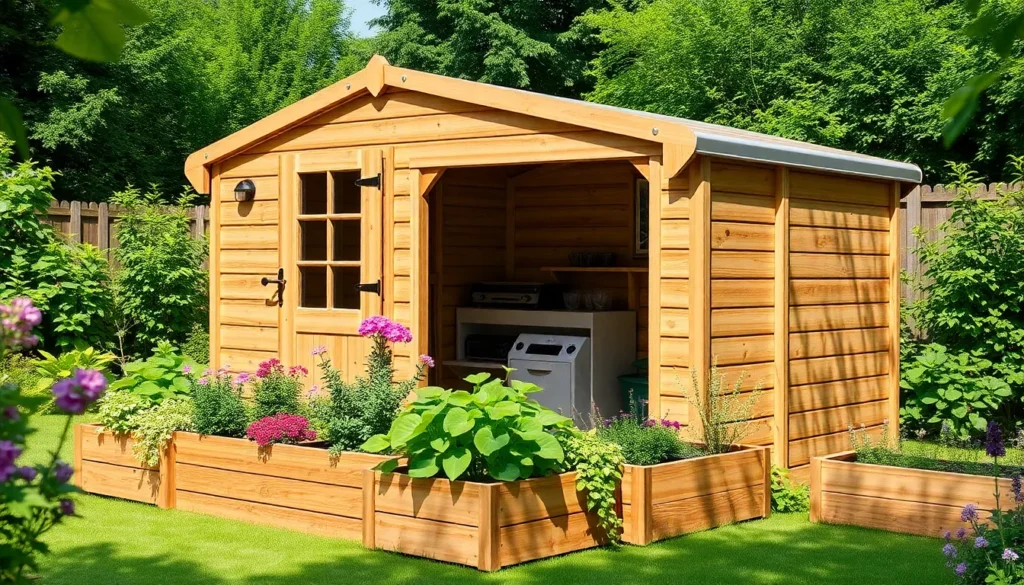In a world where plastic seems to outnumber people, sustainable living innovations are like a breath of fresh air—or maybe a whiff of that organic kale smoothie everyone’s raving about. As climate change looms larger than your neighbor’s inflatable holiday decorations, it’s time to explore how creativity and technology are teaming up to save the planet, one eco-friendly gadget at a time.
From solar-powered coffee makers to composting toilets that could make even the most reluctant gardener swoon, these innovations aren’t just good for Mother Earth; they’re downright cool. So grab your reusable shopping bag and buckle up, because the journey into the world of sustainable living is about to get exciting—and yes, there’ll be puns. After all, who said saving the planet couldn’t be a little fun?
Table of Contents
ToggleOverview of Sustainable Living Innovations
Sustainable living innovations address the critical need for eco-friendly solutions in daily life. Developers prioritize sustainability by integrating technology and creativity. Solar-powered products, like solar-powered coffee makers, offer practical energy solutions while reducing reliance on fossil fuels. Composting toilets exemplify how modern design meets environmental concerns, converting waste into compost and minimizing water usage.
Innovative materials play a significant role; bioplastics, derived from renewable sources, replace traditional plastics in various applications. Homes equipped with energy-efficient appliances save on energy costs and reduce carbon footprints simultaneously. Urban gardening solutions like vertical gardens utilize limited space effectively, promoting local food production.
Smart home technology enhances sustainability through energy monitoring and automation. Devices connect to apps, allowing users to track energy consumption and optimize usage. Electric bicycles and scooters provide alternatives to cars, lowering emissions and improving urban air quality.
Circular economy practices encourage businesses and consumers to recycle and repurpose materials effectively, reducing waste and conserving resources. Companies adopt sustainable packaging solutions, using biodegradable or recyclable materials that mitigate environmental impact.
Investing in renewable energy solutions, such as wind and solar power, supports a transition to cleaner energy sources. Individuals embrace these innovations, making choices that benefit the planet while maintaining convenience and comfort. Global initiatives focused on reducing plastic waste emphasize community involvement and innovation in addressing pressing environmental challenges.
Renewable Energy Solutions
Renewable energy solutions play a crucial role in the transition toward sustainable living. Innovations in solar and wind energy significantly reduce dependency on fossil fuels.
Solar Power Advancements
Solar power advancements continuously enhance efficiency and accessibility. Recent developments include solar panels that integrate seamlessly into roofing materials, generating electricity without compromising aesthetics. Residential installations have become more common, providing homeowners with energy independence. Moreover, solar batteries now store excess energy for use at night or during outages. These innovations support sustainability by reducing peak energy demands. Incentives, such as tax credits and rebates, encourage adoption in various regions, driving the growth of residential solar systems.
Wind Energy Developments
Wind energy developments showcase impressive technological progress. Turbines are now more compact and efficient, capturing more wind energy with less land. Offshore wind farms are expanding rapidly, harnessing stronger winds over oceans to generate significant power. Increased energy output translates to lower costs for consumers, making wind energy more competitive against traditional sources. Furthermore, innovations in energy storage systems allow for better management of wind-generated electricity. Community wind projects empower local residents to invest in renewable energy while benefiting environmentally.
Sustainable Agriculture Techniques
Sustainable agriculture techniques promote environmentally friendly practices that enhance food production while preserving resources. Innovations in this field significantly contribute to sustainable living.
Urban Farming Initiatives
Urban farming initiatives create green spaces within cities, allowing residents to grow food locally. Community gardens often transform vacant lots into productive areas, fostering a sense of community and improving food access. These projects utilize innovative methods like vertical gardening and hydroponics, maximizing limited space. Cities like Detroit and New York City implemented programs to support urban agriculture, demonstrating its potential to reduce carbon footprints. Local food production not only cuts transportation emissions but also encourages healthier eating habits.
Permaculture Practices
Permaculture practices emphasize designing agricultural systems that mimic natural ecosystems. This approach prioritizes biodiversity, soil health, and water conservation. Techniques such as crop rotation, companion planting, and natural pest control enhance productivity while maintaining ecological balance. Many permaculture practitioners advocate for closed-loop systems where waste products become resources. These methods minimize chemical inputs and reduce environmental impact, contributing to a sustainable agricultural future. Successful examples exist globally, showcasing permaculture’s potential to revitalize degraded lands.
Waste Reduction Innovations
Innovations in waste reduction play a crucial role in sustainable living. Various techniques and technologies aim to minimize waste generation and promote recycling and composting.
Recycling Technologies
Recycling technologies have evolved significantly, improving the efficiency of waste management. Next-generation sorting systems utilize artificial intelligence to identify and separate materials accurately. These advancements increase recovery rates for metals, plastics, and paper products. Some facilities now incorporate robotics, allowing for faster processing and reducing human error. Companies are also developing chemical recycling processes that can break down plastics into their original monomers, offering a solution for materials that traditional recycling cannot handle. By focusing on improving these technologies, communities can reduce landfill waste and promote a circular economy.
Composting Methods
Composting methods continue to gain popularity as effective waste reduction strategies. Home composting systems allow individuals to transform kitchen scraps and yard waste into nutrient-rich soil amendments. Various options, such as vermicomposting, use worms to accelerate decomposition, making this method efficient for urban dwellers. Moreover, large-scale composting facilities process organic waste from restaurants and grocery stores, diverting significant amounts from landfills. Some cities even implement community composting programs, encouraging residents to participate in local sustainability efforts. Enhancing awareness about composting practices helps communities reduce organic waste while enriching soil health.
Eco-Friendly Transportation Options
Sustainable transportation options play a vital role in reducing carbon footprints. These innovations include electric vehicles and advancements in public transit.
Electric Vehicles
Electric vehicles (EVs) significantly decrease greenhouse gas emissions. Many manufacturers now produce a variety of models, catering to diverse needs and budgets. For instance, brands like Tesla and Nissan have popularized electric cars, while manufacturers like BMW and Ford have introduced electric SUVs. Charging infrastructure is expanding, with over 150,000 public charging stations across the U.S. This growth enhances convenience for EV owners. As battery technology improves, range anxiety becomes less of a concern, allowing drivers to travel further on a single charge. Additionally, incentives such as tax rebates encourage consumers to adopt these eco-friendly alternatives.
Public Transit Improvements
Innovations in public transit systems aim to enhance efficiency and sustainability. Many cities invest in electric buses, which reduce emissions while meeting rising demand for urban mobility. Improved transit schedules and apps promote ridership by ensuring more convenient travel options. For instance, cities like Los Angeles and Chicago have introduced real-time tracking for buses and trains, enhancing the user experience. Additionally, some municipalities are developing light rail systems, contributing to lower traffic congestion and pollution. Prioritizing bike lanes and pedestrian-friendly infrastructure also encourages sustainable commuting, fostering healthier lifestyles and reduced reliance on personal vehicles.
Sustainable living innovations are reshaping how individuals interact with their environment. By embracing technology and creativity, people can adopt eco-friendly practices that blend seamlessly into their daily lives. From solar-powered gadgets to innovative agricultural techniques, these advancements not only address pressing environmental challenges but also enhance quality of life.
As communities rally around these solutions, the potential for a greener future becomes increasingly tangible. By prioritizing sustainability and supporting local initiatives, everyone can contribute to a healthier planet. The journey toward sustainable living is not just about making changes; it’s about enjoying the process and inspiring others to join in.










